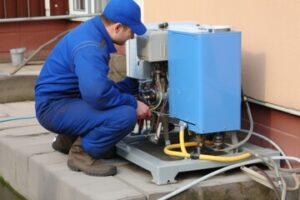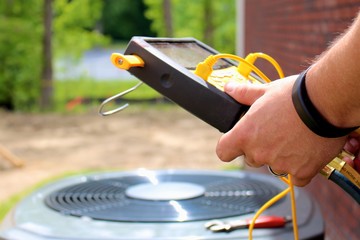Enhancing Indoor Comfort with Modern HVAC Systems
An HVAC system plays a crucial role in maintaining indoor comfort. It regulates temperature, humidity, and air quality to create a comfortable environment.
Modern HVAC systems are designed to be efficient and adaptable to different climates. They offer solutions for heating, cooling, and ventilation in residential and commercial spaces. Contact Ausco Air Heating & Air Conditioning for professional help.
Heating is a key function of HVAC systems, especially in colder months. Furnaces and heat pumps are commonly used to generate and distribute heat. Warm air is circulated through ducts or radiators to maintain a consistent temperature. Proper heating ensures comfort and protects against cold-related issues like frozen pipes.
Cooling systems help maintain a comfortable temperature during hot weather. Air conditioning units extract heat from indoor air and release it outside. This process reduces humidity and creates a cooler indoor atmosphere. Consistent cooling improves comfort and prevents heat-related health issues.
Ventilation is essential for maintaining air quality. Fresh air is introduced into the system, while stale air is removed. Filters trap dust, allergens, and pollutants to improve air quality. Proper ventilation reduces odors and prevents the buildup of harmful contaminants.
Modern HVAC systems often use smart technology to improve efficiency. Programmable thermostats allow users to set temperature preferences for different times of the day. Sensors adjust heating and cooling based on occupancy and outdoor conditions. Automation enhances comfort while reducing energy consumption.
HVAC systems rely on a network of ducts to distribute air throughout the building. Proper ductwork design ensures even airflow and minimizes energy loss. Leaks or blockages in the ducts can reduce efficiency and increase energy costs. Regular inspection and maintenance keep ducts in optimal condition.
Energy efficiency is a major focus in modern HVAC design. High-efficiency systems use less energy to produce the same level of comfort. Features like variable-speed motors and multi-stage compressors improve performance. Lower energy consumption reduces utility bills and environmental impact.
Humidity control is an important aspect of HVAC performance. High humidity can cause discomfort and promote mold growth. Dehumidifiers remove excess moisture from the air to maintain a balanced humidity level. Proper humidity control protects furniture and building materials from damage.
HVAC systems also include air purification features. HEPA filters and UV lights are used to eliminate bacteria, viruses, and allergens. Clean air improves respiratory health and reduces allergy symptoms. Regular filter replacement ensures consistent air quality.
Zoning systems allow different areas of a building to be heated or cooled independently. Dampers in the ductwork control the flow of air to each zone. This allows for customized comfort and reduces energy waste. Zoning systems are ideal for multi-level homes and large buildings.
Heat recovery ventilators (HRVs) and energy recovery ventilators (ERVs) enhance ventilation efficiency. They capture heat from outgoing air and transfer it to incoming fresh air. This process reduces energy loss while maintaining indoor air quality. HRVs and ERVs are especially useful in tightly sealed buildings.
HVAC systems can be powered by various energy sources. Electricity, natural gas, and renewable energy options are available. Hybrid systems combine different energy sources for improved efficiency. Choosing the right energy source depends on local availability and cost.
Installation of an HVAC system requires careful planning and expertise. Proper sizing ensures that the system can handle the building’s heating and cooling load. Oversized systems waste energy and create uneven temperatures. Undersized systems struggle to maintain comfort and increase wear on components.
Maintenance is essential for prolonging the lifespan of an HVAC system. Regular cleaning of filters, coils, and ducts prevents dust buildup and improves airflow. Professional inspections identify and address potential issues early. Preventive maintenance reduces breakdowns and repair costs.
Thermostat placement impacts HVAC performance. Thermostats should be installed away from direct sunlight and heat sources. Incorrect placement can cause false readings and inefficient operation. Smart thermostats adjust to user preferences and environmental changes automatically.
Insulation plays a key role in HVAC efficiency. Proper insulation reduces heat loss in winter and heat gain in summer. Sealing gaps around windows and doors prevents drafts. Well-insulated homes require less energy to maintain a comfortable temperature.
HVAC systems are also used in industrial and commercial settings. Large-scale systems require complex ductwork and zoning to handle different usage areas. Commercial HVAC units often have rooftop installation to save space. Industrial HVAC systems regulate temperature and humidity in manufacturing processes.
Noise levels are a consideration in HVAC design. Quiet operation enhances comfort, especially in residential settings. Vibration isolation and sound-dampening materials reduce noise from fans and compressors. Proper installation and maintenance also minimize operational noise.
Airflow balancing ensures consistent comfort throughout the building. Adjusting dampers and registers allows for even distribution of heated or cooled air. Unbalanced airflow can cause hot and cold spots. Professional balancing improves comfort and system efficiency.
HVAC systems are increasingly integrated with smart home technology. Mobile apps allow users to control temperature settings remotely. Smart systems learn user preferences and adjust settings automatically. Integration with weather data optimizes performance based on outdoor conditions.
Environmental impact is a growing concern in HVAC design. Refrigerants with low global warming potential (GWP) are now used in cooling systems. Energy-efficient designs reduce carbon emissions and lower utility costs. Sustainable HVAC solutions contribute to environmental conservation.
HVAC retrofitting involves upgrading older systems with modern components. Retrofitting improves energy efficiency and performance. New controls, compressors, and fans enhance system operation. Retrofitting extends the lifespan of an existing system and reduces energy costs.
Backup systems ensure continuous comfort during power outages. Generators or battery storage systems provide emergency power. Backup heating and cooling prevent temperature extremes and protect against damage. Reliable backup systems increase resilience in adverse conditions.
HVAC systems are also used for air pressure control. Positive and negative pressure rooms are used in healthcare and laboratory settings. Proper pressure control prevents contamination and maintains sterile conditions. HVAC systems with advanced pressure regulation are essential in specialized environments.
Climate control in data centers and server rooms is critical for equipment performance. High heat output from servers requires efficient cooling solutions. Precision air conditioning maintains stable temperatures and humidity levels. Reliable climate control prevents overheating and equipment failure.
Advanced filtration systems remove volatile organic compounds (VOCs) and harmful gases. Activated carbon filters and UV lights enhance air purification. Removing VOCs improves indoor air quality and protects respiratory health. Clean air reduces fatigue and increases comfort.
HVAC systems can include humidification features for dry climates. Humidifiers add moisture to the air to prevent dryness and irritation. Proper humidity levels improve skin and respiratory health. Controlled humidity protects wooden furniture and musical instruments from damage.
Seasonal changes impact HVAC performance and energy use. Winter and summer require different system settings and maintenance schedules. Adjusting thermostat settings and sealing gaps improve seasonal efficiency. Preparing the system for seasonal changes prevents wear and damage.
HVAC professionals require specialized training and certification. Technicians need to understand refrigerant handling, electrical systems, and air distribution. Licensing ensures that professionals meet safety and performance standards. Ongoing education keeps technicians updated on industry advancements.
HVAC systems are essential for modern comfort and health. They regulate temperature, humidity, and air quality to create a safe environment. Advances in smart technology and energy efficiency improve performance and convenience. Investing in a reliable HVAC system enhances comfort and long-term savings.

